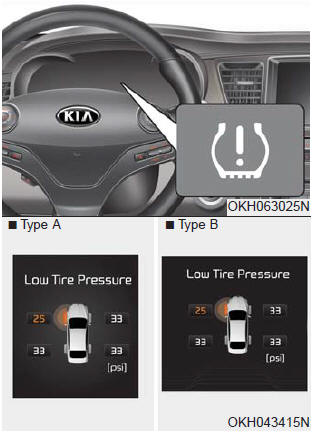 Kia K900: Tire pressure monitoring system (TPMS)
Kia K900: Tire pressure monitoring system (TPMS)

(1) Low Tire Pressure Telltale/TPMS Malfunction Indicator
(2) Low Tire Pressure Position Telltale (shown on the LCD display)
Each tire, including the spare (if provided), should be checked monthly when cold and inflated to the inflation pressure recommended by the vehicle manufacturer on the vehicle placard or tire inflation pressure label.
(If your vehicle has tires of a different size than the size indicated on the vehicle placard or tire inflation pressure label, you should determine the proper tire inflation pressure for those tires.)
As an added safety feature, your vehicle has been equipped with a tire pressure monitoring system (TPMS) that illuminates a low tire pressure telltale when one or more of your tires is significantly under-inflated.
Accordingly, when the low tire pressure telltale illuminates, you should stop and check your tires as soon as possible, and inflate them to the proper pressure.
Driving on a significantly under-inflated tire causes the tire to overheat and can lead to tire failure. Under-inflation also reduces fuel efficiency and tire tread life, and may affect the vehicleŌĆÖs handling and stopping ability.
Please note that the TPMS is not a substitute for proper tire maintenance, and it is the driverŌĆÖs responsibility to maintain correct tire pressure, even if under-inflation has not reached the level to trigger illumination of the TPMS low tire pressure telltale.
Your vehicle has also been equipped with a TPMS malfunction indicator to indicate when the system is not operating properly. The TPMS malfunction indicator is combined with the low tire pressure telltale. When the system detects a malfunction, the telltale will flash for approximately one minute and then remain continuously illuminated.
This sequence will continue upon subsequent vehicle start-ups as long as the malfunction exists.
When the TPMS malfunction indicator remains illuminated after blinking for approximately 1 minute, the system may not be able to detect or signal low tire pressure as intended.
TPMS malfunctions may occur for a variety of reasons, including the installation of replacement or alternate tires or wheels on the vehicle that prevent the TPMS from functioning properly.
Always check the TPMS malfunction telltale after replacing one or more tires or wheels on your vehicle to ensure that the replacement or alternate tires and wheels allow the TPMS to continue to function properly.
✽ NOTICE
If any of the below happens, have the system be checked by an authorized K900 Kia dealer. The low tire pressure telltale/ TPMS malfunction indicator does not illuminate for 3 seconds when the ignition switch is turned to the ON or engine is running. The TPMS malfunction indicator remains illuminated after blinking for approximately 1 minute. The Low tire pressure position telltale remains illuminated.
Low tire pressure telltale

- Low tire pressure position telltale
- TPMS (Tire Pressure Monitoring System) malfunction indicator
- Changing a tire with TPMS
- Pursuant to Code of Federal Regulations, Title 47, Part 15 ("FCC Rules").
 Engine overheat
Engine overheat
If your temperature gauge indicates overheating, you experience a loss of power,
or hear loud pinging or knocking, the engine is probably too hot. If this happens,
you should:
1.Pull off the road ...
 Low tire pressure position telltale
Low tire pressure position telltale
When the tire pressure monitoring system warning indicators are illuminated and
warning massage displayed on the cluster LCD display, one or more of your tires
is significantly under-inflated.
...
See also:
Pursuant to Code of Federal Regulations, Title 47, Part 15 ("FCC Rules").
Operation is subject to the following two conditions:
1.This device may not cause harmful interference, and
2.This device must accept any interference received, including interference that
may cau ...
Head Up Display Information
1.Turn By Turn navigation information
2.Road signs
3.Speedometer
4.Cruise setting speed
5.Advanced Smart Cruise Control (ASCC) information
6.Lane Departure Warning System (LDWS) information
7. ...
Tilt Steering/Telescope Steering
Adjust the steering wheel angle (2) and position (3) with the knob (1) on the
steering column. Move the steering wheel, so it points toward your chest, not toward
your face.
Make sure you can ...
